How to propagate, transplant and prune a tangerine tree at home?
Among exotic plants, citrus fruits are especially popular. To grow tangerine tree and even with fruits at home - the dream of every gardener. You should not be afraid of difficulties with evergreen pets in tubs. Caring for them is the same as for other heat-loving plants.
An evergreen tangerine tree will decorate not only a winter garden or a greenhouse, but undersized varieties are suitable for home decor. And if the tree begins to bear fruit, it will supply the owners with tasty, juicy citrus fruits, not to mention their benefits for the body.
Content:
- Features of indoor mandarin
- Citrus propagation methods
- Growing conditions: lighting, humidity, temperature
- Difficulties in caring for a tree: watering, feeding, transplanting
- The role of tangerine pruning in crown formation
- Diseases and pests of plants, methods of dealing with them
Features of indoor mandarin
Of all citrus fruits, mandarin can be grown both indoors and in the garden in warm climates. A small tangerine tree branches strongly. Its crown of light gray stems is covered with leathery lanceolate leaves. Green plates are located on small petioles. The lifespan of one leaf reaches four years.
During the year, three growing seasons are observed in the tree: in spring, autumn and winter.
Mandarin blossoms begin in May, and the fruits ripen at the end of October. The clusters of inflorescences are decorated with small white flowers. They are distinguished by a pleasant aroma. Fruiting of the plant occurs in the third - fourth year of life, and then, under normal conditions, annually. At first, the oval, slightly flattened fruit has a green rind.
But over time, it turns orange. The rind separates easily from the pulp, which tastes sour, although with a little sugar. There are also sweet varieties of tangerines.
Bred for indoor floriculture varieties of dwarf trees, reaching a height of 40-50 centimeters. Tangerine tree in the home, it can become a decoration and bear delicious fruits.
Citrus propagation methods
You can grow tangerines at home in different ways:
- Propagated by seeds if the seed is taken from a varietal tree. Place the seed in a damp cloth and wait for the seedlings to peck. After that, the seeds are placed in a nutrient substrate. It is important to know that plants obtained from seeds produce fruits, but inedible ones.
- The situation with fruiting can be corrected by grafting a one-year-old or two-year-old cuttings to the wild. Having made a cut on the tree with the letter T, move the bark aside and insert scion... The place of contact is smeared with garden varnish, tied with a cloth. The branch will take root in three weeks. You can vaccinate by crossing a tangerine with another citrus: orange, grapefruit, lemon.
- Cuttings for vegetative propagation are obtained from a varietal tree or purchased in a specialized store. The shoot is planted in a container with nutritious loose soil. After planting, watered abundantly and covered with a plastic bottle on top. The twig will take about two months to take root.
You can choose a reproduction method taking into account the skill of the grower, his experience.
Growing conditions: lighting, humidity, temperature
The tangerine tree belongs to the cultures that grow in the countries of the East, where there is a lot of sun and warmth. Place pots with a plant on the southeast, southwest side of the house. If the sun shines brightly at noon, then the leaves of the tangerine tree should be shaded.
But in winter, the lack of light is compensated by the organization of backlighting. A fluorescent lamp is suspended at a distance of 20-30 centimeters from the container with tangerine. Indoor humidity does not play a special role in the development of the tree. It should be at the level of 50-60 percent. The plant tolerates a slight drought easily.
Among the conditions for growth, illumination is important for a citrus plant; if it is lacking, the tree will begin to shed its leaves.
And the optimal temperature for keeping indoor tangerine is in the summer from 18 to 25 degrees Celsius. In winter, the temperature is reduced to plus ten. If the tree rests in winter, then it will begin to develop more actively in the spring.
Difficulties in caring for a tree: watering, feeding, transplanting
Care tangerine will give joy and satisfaction if the result is delicious fruits:
- Watering tangerine is organized depending on the size of the plant. A large number of leaves on a crop also requires a lot of moisture. With the lengthening of daylight hours, frequent and abundant watering of the citrus tree is assumed, because the liquid evaporates faster. Water the pots in the morning when the vitality of the plant is activated. A decrease in temperature values leads to a decrease in the frequency of humidification. Together with watering, foliage is also sprayed. During the flowering of the tangerine, they try to take a shower so that water does not get on the buds.
- During the growing season of a room culture, the soil is quickly depleted, therefore, without top dressing, the tangerine will have a hard time. Fertilizers are applied more intensively in early spring, when the buds begin to awaken. The complex nutrient substrate should contain a sufficient amount of nitrogen, potassium for tangerine, and slightly less phosphorus. One cap of a complex product is added to a liter of well-settled water and watered with a plant solution. From organic dressings they use mulleindiluted 1:10. Every two weeks they feed during spring, summer and early autumn, and in winter they reduce the amount of fertilizer to a minimum.
- Young plants need an annual transplant, since the tangerine develops rapidly and its capacity becomes small. A new pot is selected six to eight centimeters larger in diameter than the previous one. The soil substrate is placed in a container on top of a layer of expanded clay. The soil should be composed of humus, peat, leafy earth and sand. Mandarins prefer acidified soil. A method of transplanting a tree by transshipment. The best time for the procedure is early spring. A few days before transplanting, the tree is not fed and rarely watered. Before transplanting, the plant is abundantly moisturized. Remove the bush and carefully place it in a new container. Sprinkled with earth, watered tangerine. A tree over seven years old can be transplanted less often as the pot fills with roots.
The role of tangerine pruning in crown formation
It is imperative to prune the crown of a tangerine tree every spring. In addition to giving the plant beauty, pruning will help to heal and rejuvenate the culture. Shoots of trees are also cut in order to stimulate the formation of new buds.And after flowering, by cutting out weak branches with a slight branching, they help the tree to grow.
But you cannot cut off shoots with fruits.
To create a crown type bonsai cut off side shoots, branches growing inward or downward. And for the rest, they pinch the tops. Preventive pruning consists of removing dead and diseased branches. On young twigs, part of the ovaries is removed, leaving one in twenty leaves. This will allow the fruit to ripen qualitatively. With the growth of the trees, the number of ovaries left increases.
Be sure to carry out the procedure with a sharp knife or scissors, previously disinfected. Cut points are covered up garden pitch or sprinkled with activated carbon. Pruning is a must when growing tangerines at home.
Diseases and pests of plants, methods of dealing with them
Mandarin diseases can be associated with both improper care and the defeat of the plant by fungal infections. The yellowing of the leaves of the tree occurs due to a lack of moisture or overfeeding with fertilizers. If, when eliminating the causes, the tree continues to hurt, then it is necessary to identify the symptoms of the disease:
- When a viscous brown liquid - gum begins to stand out from the trunk of the tree, the plant is affected by insects or there are a lot of potash fertilizers in the soil. In this case, the tangerine is transplanted, not forgetting to put a drainage layer in a new pot.
- The appearance of sticky soot deposits on the leaves indicates an infection. With the help of a tampon moistened with water, plaque is washed off, and a shower is arranged for the tree.
- Spots on the leaves are caused by parasitic fungi. It is necessary to quickly spray the plant with fungicides, otherwise the tangerine will die.
- Anthracnose recognized by the dark brown spots on the leaves, similar to burns. The disease is provoked by a large amount of moisture in the air, a lack of phosphorus and potassium in the soil. Rotting branches are pruned, and the bush is processed fungicidal preparation.
- Powdery mildew appears as a white bloom on parts of the plant. A remedy containing copper, as well as airing the room, will save the tree from disease.
Of the pests are dangerous for mandarin aphid, spider mite, scale insect. You can control pests manually by collecting their colonies from the leaves. Spraying with soapy water will also help. From folk remedies, infusion of garlic destroys spider mites.
With a strong defeat, you cannot do without insecticides... Processing is carried out three times with an interval of ten to twelve days. Compliance with the rules of care, the conditions for growing tangerine will allow the tree to remain clean from fungi and pests. It is interesting to grow a tangerine tree at home. It will give joy and beauty during flowering and fruiting.
More information can be found in the video:




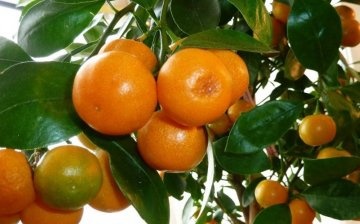
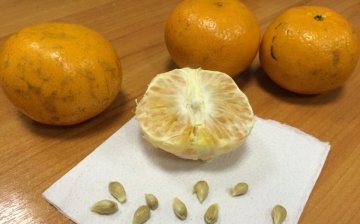

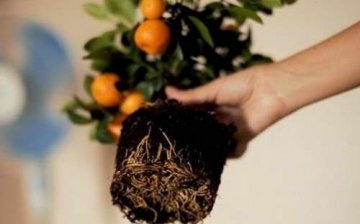









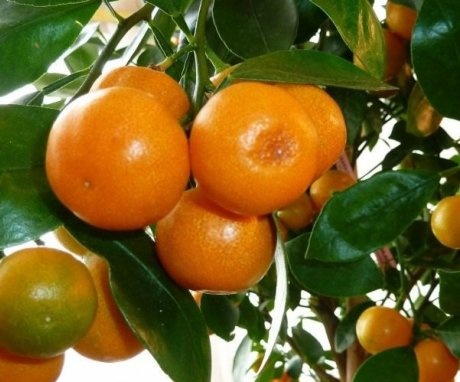
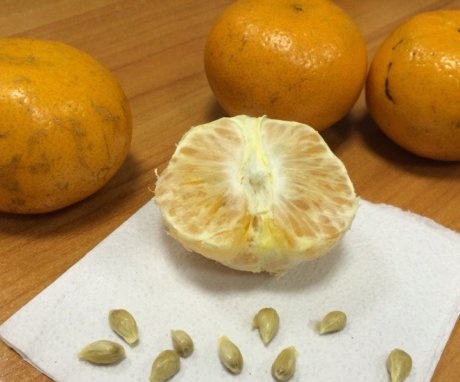




They gave me a tangerine tree for my birthday. The tangerines were very tiny and green, then they ripened. Sooooo sour! I peeled them off and cooked them whole with a lot of sugar. It turned out beautifully. The taste is harsh, but original. I look forward to a new harvest.